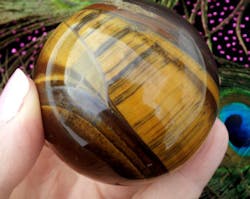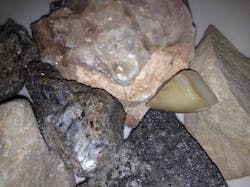I've been a rockhound for as long as I can remember. Growing up outside San Diego, the family spent a lot of time in the nearby desert picking up and digging for rocks of all kinds. Fast-forward nearly 50 years, and I'm still fascinated by rocks and gems and the endless variety that nature seems to conjure. Most particularly, the general population (myself included) is drawn to the most colorful, iridescent, and—my husband's own favorite—shiny and valuable gemstones.
We've probably all seen the colorful prisms that form as light is refracted through a diamond, but have you ever seen a star sapphire and appreciated the truly amazing form that this otherwise rough stone takes after polishing purely due to its interaction with light? As seen in the YouTube video below, star sapphires exhibit the quality of asterism (see http://www.thenaturalsapphirecompany.com/education/sapphire-varieties/star-sapphires/), whereby light refracts through small "needles" of the mineral rutile and forms the natural star shape. If you find a star sapphire with a perfectly shaped star, or the star doesn't move with the light as you rotate the stone around, it's probably a fake.
Although I'm well versed in the varieties of many local gems and minerals in my own geographical area, the study of gemology is complex. A common name for the study of how light interacts with gems and minerals is "optical gemology", and if you're interested, there is a very comprehensive summary of the subject from now-retired College of Southern Nevada professor Barbara Smigel at http://www.bwsmigel.info/lesson4/de.optical.properties.html. Just a sample of some optical gemology properties include luster, transparency, and color. Her online free lessons are fantastic, as are the images that accompany them.
While the interaction of natural light with gemstones is phenomenal enough, certain rocks hide fabulous properties such as fluorescence under ultraviolet light (see an image of my own modest collection below comparing the natural and UV light result). If you ever want to explore further, check out the properties of phosphorescent minerals that glow after the UV light is removed; these minerals are often characterized by their phosphorescence lifetime.And so now I have a reader challenge: A few years ago I visited a laser glass manufacturer and obtained some scrap YAG crystalline material. A gemologist up in Washington state cut the crystal into two rather large and matching custom stone designs for my sister and I. While a bit cloudy in appearance, the crystals have the characteristic pink/purple color of YAG in visible/natural light, but appear just as clear as a diamond under artificial fluorescent lighting. Do you know why? I was given the answer once, but maybe there are some "optical gemologists" out there that can enlighten me again.





